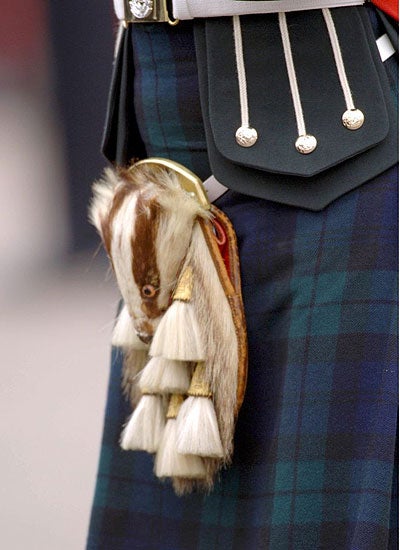Scotsman's sporran doomed by European ban on sealskins

The Highland kilt must rank as one of the most distinctive and manly items of clothing that the world has ever seen. But it has no pockets. Braveheart warrior types, though, were never going to resort to carrying some kind of proto man bag. So the sealskin sporran was born.
Now, however, centuries of tradition look set to be overturned after the European Commission moved a step closer to a complete import ban on seal products. At present, 90 per cent of sporrans are fashioned from the mammal's hide, prompting warnings from traditional Highland dressmakers that the change in the law could spell disaster for the thriving industry.
The move, announced yesterday by the European environment commissioner Stavros Dimas, was warmly received by animal welfare groups which have campaigned to end what they regard as the inhumane slaughter of seals. But others believe it could mean an end to a distinctive feature of Scottish heritage.
Ian Chisholm, who owns a Highland dress business in Inverness, said: "Sealskin has been a traditional skin used by the Highlanders for many years. It would be a sad day for the Scotsman if we lost the use of seal skin."
Robin McClintock, who produces 4,000 sporrans a year from his base at Bonnyrigg near Edinburgh, warned that it could open the floodgates for cheap imports from southern Asia that threaten to kill off the traditional Scottish sporran-making industry. "What is keeping them out at the moment is the high price of seal skin – it is so expensive. If it is banned, they will use cow or rabbit skins," he said.
At present, seal remains the skin of choice among discerning sporran wearers. "Its look, its feel, there are all sorts of reasons and emotions tied up with seal skin sporrans, there really are," he added. "Sporrans make up only a tiny proportion of seal skins, most go to the Far East to make coats. A ban will affect many cultures outside Scotland, particularly those of the Inuit who hunt them," he added.
Almost all the sealskins used to make the pouches are treated in Norway. Many of the pelts make their way there from Canada, where hunters carry out the biggest cull in the world, and which along with Greenland and Namibia accounts for 60 per cent of the 900,000 seals culled annually.
But seal-hunting also goes on within the EU, both in Scandinavia and the UK. Announcing the move, which must receive the backing of the European Parliament and the 27 member governments before it becomes law, Mr Dimas said the trade in seal products would be allowed only where it could be guaranteed that hunting techniques met with high animal welfare standards and that the animals did not suffer unnecessarily.
Ross Minett, the campaigns director at Advocates for Animals, welcomed the announcement. He said that while the majority of people saw the wearing of fur as wrong, "sporrans are one of the few things where it's still seen as publicly acceptable to wear fur."
Interest in traditional Highland dress and the original sporran has been growing in recent years. One of the main growth areas has been among Scottish football fans, according to Hamish Husband, spokesman for the Association of Tartan Army Clubs. "In the past 10 years there has been a sea change in the wearing of the kilt and the sporran by the Tartan Army. When you travel abroad you see thousands of people wearing kilts."
But seal is not the only controversial skin to be used. In June, kilt wearers were warned that they could face prosecution if they failed to produce a licence for their sporran under laws designed to protect endangered species such as otters.
Highland pouch given a Victorian makeover
The original sporran was an altogether more humble affair than the ornate versions that came to prominence during the Victorian era, courtesy of Prince Albert.
For the early Highlanders they were little more than a string-draw bag of cloth or leather in which to carry oatmeal or gunpowder. They also did a good job preserving modesty as the original rough plaid wraps were prone to billow open.
By the late 1800s, after receiving royal endorsement and riding the popularity of Sir Walter Scott, the sporran underwent a more flamboyant incarnation. Though more affluent Highlanders had long decorated their sporrans with silver and tassels, the late Victorian wearer plundered otters, badgers, goats and even hedgehogs. The sporrans got so huge that some completely covered the kilt's front. Some adornments arealready banned – among them wildcat heads.
Subscribe to Independent Premium to bookmark this article
Want to bookmark your favourite articles and stories to read or reference later? Start your Independent Premium subscription today.

Join our commenting forum
Join thought-provoking conversations, follow other Independent readers and see their replies